BRUNO'S PERIGORD
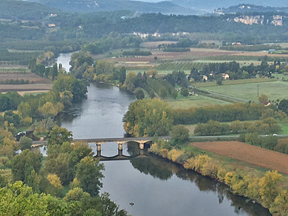 A dear friend introduced me to the novels of English author Martin Walker: Bruno, Chief of Police—set in the historic and gastronomic Dordogne region of France......these lovely books are murder mysteries, but detail a picture of village and county life in this picturesque place, with much emphasis on local food specialities and iconic wines. The mythical village of St. Denis perched over the Vezere River valley is Bruno's fiefdom—a composite of several towns in the area: St. Cyprien, Belves, Les Eyzies, Tremolat, Le Bugue and Le Buisson—many of which we will visit. Our base for wandering the byways of Bruno's Perigord is Sarlat - a honey-gold limestone town set in a hill hollow nine kilometers from the meandering Dordogne River.
A dear friend introduced me to the novels of English author Martin Walker: Bruno, Chief of Police—set in the historic and gastronomic Dordogne region of France......these lovely books are murder mysteries, but detail a picture of village and county life in this picturesque place, with much emphasis on local food specialities and iconic wines. The mythical village of St. Denis perched over the Vezere River valley is Bruno's fiefdom—a composite of several towns in the area: St. Cyprien, Belves, Les Eyzies, Tremolat, Le Bugue and Le Buisson—many of which we will visit. Our base for wandering the byways of Bruno's Perigord is Sarlat - a honey-gold limestone town set in a hill hollow nine kilometers from the meandering Dordogne River.
Our small flat for the week, up narrow Rue Presidial, a block off the central Place de Liberte', is two levels with a wooden corkscrew staircase and narrow stone balcony overlooking the street. An enormous limestone fireplace dominates the main level of seating, dining and open kitchen areas, but disappointingly, the ownership does not allow wood fires for guests. That corkscrew staircase will prove a nemesis, as one of us will slip, fall, and break a toe, which will be many months in the healing.
Save for some modern shop fronts at the ground level, old Sarlat is little changed over the centuries. An hour's 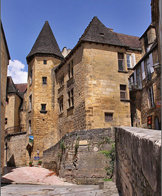 guided walking tour orients us and provides some historical context. Built over several hundred years from medieval through Renaissance times, the town's architecture mixes gothic, Romanesque, and classical styles in its elegant townhouses, square towers and round, witch-hat topped turrets—all at odd and curious angles to one another. One can almost imagine Frank Gehry getting his original inspiration from Sarlat for his jumbled massing of shapes. The 9th c. monastic Cathedrale St Sacerdos, originally the Sarlat Abbey church and the adjoining Bishop's Palace mix all these styles one atop the other. Imposing 15th, 16th & 17th century Hotels Particuliere line the rue des Consuls and Rue Alberic Cahuet. If you hid those more modern shop fronts, another Three Musketeers movie could easily be shot in Sarlat.
guided walking tour orients us and provides some historical context. Built over several hundred years from medieval through Renaissance times, the town's architecture mixes gothic, Romanesque, and classical styles in its elegant townhouses, square towers and round, witch-hat topped turrets—all at odd and curious angles to one another. One can almost imagine Frank Gehry getting his original inspiration from Sarlat for his jumbled massing of shapes. The 9th c. monastic Cathedrale St Sacerdos, originally the Sarlat Abbey church and the adjoining Bishop's Palace mix all these styles one atop the other. Imposing 15th, 16th & 17th century Hotels Particuliere line the rue des Consuls and Rue Alberic Cahuet. If you hid those more modern shop fronts, another Three Musketeers movie could easily be shot in Sarlat.
The morning after we arrive the Wednesday market meanders into winding cobbled lanes and narrow partially covered passages from the Cathedrale to the 17th c. Marie on the Place de Liberte. Perigord is duck, goose, boar, mushroom, walnut and truffle country, and all are in evidence in various market stalls. Fresh and tinned foie gras from a few ounces to kilos; blood red magret duck breasts and confit legs in creamy fat; mounds of gnarled boar and deer sausages, dried crepes and girolles, and 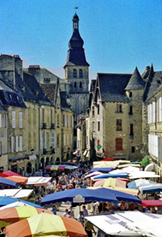 cheeses from tiny rounds of goat cabecous to enormous wheels of brebis. Walnuts are also everywhere—vin de noix, gateaux de noix, huile de noix, and delicate
cheeses from tiny rounds of goat cabecous to enormous wheels of brebis. Walnuts are also everywhere—vin de noix, gateaux de noix, huile de noix, and delicate 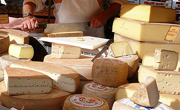 sweets and pastries. It's early for truffles, and there is but one small vendor with a few gnarled "black diamonds" arrayed on his table. The major truffle season begins in December. To stock the small flat's larder we fill the bag with pain de campagne, a small torchon of foie, brebis and crottin cheeses, thin slices of jambon de pays, lettuce, tomatoes and radishes for salad, and a bottle of Pecharmant rouge. Lunch out in a restaurant, and dinner in is our usual way when renting apartments in Europe.
sweets and pastries. It's early for truffles, and there is but one small vendor with a few gnarled "black diamonds" arrayed on his table. The major truffle season begins in December. To stock the small flat's larder we fill the bag with pain de campagne, a small torchon of foie, brebis and crottin cheeses, thin slices of jambon de pays, lettuce, tomatoes and radishes for salad, and a bottle of Pecharmant rouge. Lunch out in a restaurant, and dinner in is our usual way when renting apartments in Europe.
In Walker's novels, Bruno and his vendor friends gather market days behind the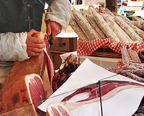 stalls mid-morning with a loaf of bread, sliced jambon, a gnarled sausage sliced into rounds with the ubiquitous Opinel folding knife, a round of chèvre, and bottle of Bergerac for casse-croûte—literally "break crust"—a tradition hailing to long farm days which begin in the fields at dawn, after a meager cup of coffee and croissant.
stalls mid-morning with a loaf of bread, sliced jambon, a gnarled sausage sliced into rounds with the ubiquitous Opinel folding knife, a round of chèvre, and bottle of Bergerac for casse-croûte—literally "break crust"—a tradition hailing to long farm days which begin in the fields at dawn, after a meager cup of coffee and croissant.
After marketing, we nip into The Jimmy's (Miami) Bar overlooking the Place for our own version of casse-croûte—a restorative coup de champagne and cold glass of Stella Artois. Jimmy's will become our local for the stay—it's a curious mix of typical French cafe outside, and 50's turquoise and red 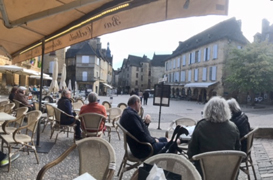 Naugahyde and chrome inside.....classic rock and roll blasting all the while.
Naugahyde and chrome inside.....classic rock and roll blasting all the while.
Sarlat is a great central location for exploring the Vezere and Dordogne River valleys. The Vezere is sometimes called the cradle of pre-history—it loops and twists its way southwest from its source in the Limousin Parc, into the Perigord and through Montignac, where one can visit the reproduction caves of Lascaux 2 (the originals having been closed since 1963 to prevent further damage from visitation). There are dramatic limestone cliffs through the valley, which contains numerous original sites of early man—grottos in those cliffs, caves, and abri, or prehistoric shelters that can be visited in the original. At the same time the Vezere is winding through a bouquet of lovely villages that carry either or both the appellations Village Fleuri, or Les Plus Beaux Villages de France: Saint Leon Sur Vezeres, and Les Eyzies being two of the most lovely. Between 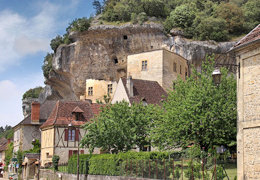 the two lies La Roque St Christophe, with ancient shelters built into the cliff ledges, inhabited from 55,000 years ago into the Middle Ages.
the two lies La Roque St Christophe, with ancient shelters built into the cliff ledges, inhabited from 55,000 years ago into the Middle Ages.
Les Eyzies occupies a grand setting above the Vezere and below huge cliffs bedecked with live oak and juniper. It is home to the National Museum of Prehistory, housed in a spectacular modern building hunkering under the brow of the enormous rock outcrop, and we take an hour for a quick visit. Just outside of Les Eyzies is the Grottes de Font de Gaume, which contains a couple hundred amazing pre-historic rock paintings of bison, mammoth, horses and deer—considered to be the finest example of cave paintings in France outside of Lascaux. Note that access is very limited, and advance reservations are necessary.
Further downstream the charming village of Limeuil presides over the confluence of the Vezere with the Dordogne, which can be best viewed from the Jardins Panoramique at the top of the village—a sort of a low key botanic garden—with the big view, and worthy of an hour's wander. Though closed to us in mid-October, Le Chai, beside the river, is said to be one of the world’s great pizza houses serving varieties never dreamed of, with an amazing running and flying waiter.
The Dordogne itself loops and oxbows westward through Perigord, along verdant forests and fecund fields, under 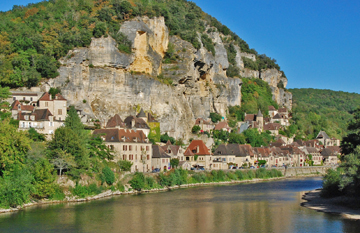 grand stone cliff parapets, through exquisite villages, and past towering castles that date to the Hundred Year's war and well before. La Roque Gageac is a stunning village of golden stone houses strung like pearls on a necklace along a ledge, perched above a bend in the river and under one of those enormous brows of limestone. Viewed from across, the village and cliffs reflect perfectly in the water below. Around the bend and across the river, Chateau Castlenaud perches high on the hill, glaring across at Chateau Beynac above the village of Beynac et Cazenac. Built in the 12 century, these two were occupied by the and English and French, respectively during the Hunded Years War —the Dordogne River being the front line. Both make for an interesting visit, but we only have time for Beynac.
grand stone cliff parapets, through exquisite villages, and past towering castles that date to the Hundred Year's war and well before. La Roque Gageac is a stunning village of golden stone houses strung like pearls on a necklace along a ledge, perched above a bend in the river and under one of those enormous brows of limestone. Viewed from across, the village and cliffs reflect perfectly in the water below. Around the bend and across the river, Chateau Castlenaud perches high on the hill, glaring across at Chateau Beynac above the village of Beynac et Cazenac. Built in the 12 century, these two were occupied by the and English and French, respectively during the Hunded Years War —the Dordogne River being the front line. Both make for an interesting visit, but we only have time for Beynac.
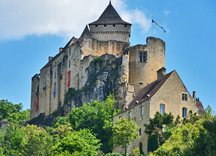 A bit further down-river, the Chateau Milandes is a charming Renaissance manor house built in 1489 by the Lord Francois Caumont and inhabited by the family through the late 1600's. It was occupied by a succession of owners and finally bought by singer Josephine Baker after her service in the French Resistance in WWII. She brought her "Rainbow Tribe" of more than a dozen adopted children of different races and ethnicity to Milandes and lived there for years. Sadly she lost the Chateau in bankruptcy, and died penniless.
A bit further down-river, the Chateau Milandes is a charming Renaissance manor house built in 1489 by the Lord Francois Caumont and inhabited by the family through the late 1600's. It was occupied by a succession of owners and finally bought by singer Josephine Baker after her service in the French Resistance in WWII. She brought her "Rainbow Tribe" of more than a dozen adopted children of different races and ethnicity to Milandes and lived there for years. Sadly she lost the Chateau in bankruptcy, and died penniless.
The Chateau is now completely full of Josephine Baker memorabilia, and is a literal museum to her career and life. The garden a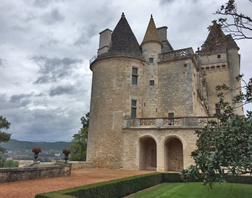 nd park was designed by Charles Claverie and Jules Vacherot, the head gardener for the City of Paris. It is lovely and worth a wander of an hour or so, to see it's many levels and different areas, including a sweeping view over the Dordogne Valley. There is also an interesting half hour demonstration of various birds of prey a couple of times a day, with hawks, falcons, and owls wheeling around and swooping onto gloved hands for reward bits of meat.
nd park was designed by Charles Claverie and Jules Vacherot, the head gardener for the City of Paris. It is lovely and worth a wander of an hour or so, to see it's many levels and different areas, including a sweeping view over the Dordogne Valley. There is also an interesting half hour demonstration of various birds of prey a couple of times a day, with hawks, falcons, and owls wheeling around and swooping onto gloved hands for reward bits of meat.
Les Jardins de Marqueyssac occupy an oblong plug of limestone rising out of the valley floor that's a kilometer long by a third wide. Rounded forms of boxwood undulate from the chateau terrace through tall pines to the western viewpoint that gives a spectacular view of the Chateau Castlenaud rising above the river, and to the right, Chateau Beynac lording over the village. Several paths meander eastward through semi-formal and rough gardens, along the cliff face to the far belvedere that yields a stunning view of La Roque Gageac. Altogether it's a two-kilometer wander out and back through forest and garden, taking in sweeping views in all directio ns.
ns.
Back in Sarlat we plan for dinner. Many restaurants in town are by now closed for the season. Those still open are largely tourist oriented, with a depressing sameness of menu—foie mi-cuit, magret de canard, confit duck leg, gizzard salad, cassoulet. The Restaurant Hotel Dieu, however, has a broader menu, and we are delighted with langoustine ravioli, small, perfectly fresh St Jacques scallops on a celery-root risotto, and slow, low cooked pork shoulder. The last bottle of their allocation of 25 per year of 2008 Chateau Corbiac proves to be a delightful smoky, fruit filled Pecharment—one of Bruno's favorite red wines—and perfect accompaniment.
The next day we head out for another sightseeing circuit of Bruno's Perigord, heading south again back to the river and across at Vitrac to arrive at Domme. One of Les Plus Beaux Village perched over the Dordogne, Domme is one of the prettier Bastide towns—originally built as new market towns that were also fortresses, with big squares for the market, defensible walls, and a sturdy church to act as bastion. After winding through narrow lanes, we find parking near the Belvedere de la Barre, a great vantage point and the start of the Promenade des Falaises - a short walk high up above the River Dordogne with really splendid views of the valley, and both Castlenaud and Beynac. The main square, Place de la Halle, spiders out with downward lanes, which feature varied architecture from half-timber buildings, to golden stone buildings with steep slate roofs and small turrets.
From Domme we take the D53 windy back road to Belves, another bastide town sited on a rocky outcrop high over the River Nauze with a wide view of the surrounding countryside. There is a preserved 15th C covered market hall, and the watchtower Guet. Arriving just before time for Sunday lunch, without reservation, we luckily find a table at the Hotel Belvedere, a former coaching inn, and the dining room is soon packed. The lone waiter is stretched, but manages to get us a simple French Sunday lunch of country pate, goat cheese salad and duck confit.
We wind back to the Dordogne River and at Tremolat take a break from driving. The best restaurant in the 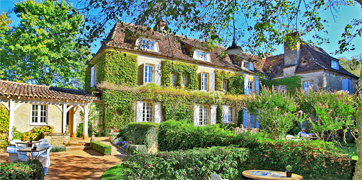 Dordogne some say (including Bruno author Walker) is Le Vieux Logis, and we stop in for a quiet drink in an elegant sitting room in front of a small fire, with a view out over their lovely manicured gardens. We lodged here many years ago, and forewent a magnificent smelling Sunday roast venison lunch in a nearby village's bistrot, because we had reservations for dinner. Unfortunately we ordered eel and lamprey, respectively, dishes that made us both wish for that venison lunch. In the main square is an offshoot of the Vieux Logis, rather simpler, called Le Bistro en Face, which would be worth a try on another trip.
Dordogne some say (including Bruno author Walker) is Le Vieux Logis, and we stop in for a quiet drink in an elegant sitting room in front of a small fire, with a view out over their lovely manicured gardens. We lodged here many years ago, and forewent a magnificent smelling Sunday roast venison lunch in a nearby village's bistrot, because we had reservations for dinner. Unfortunately we ordered eel and lamprey, respectively, dishes that made us both wish for that venison lunch. In the main square is an offshoot of the Vieux Logis, rather simpler, called Le Bistro en Face, which would be worth a try on another trip.
Back in Sarlat, our larder has the two legs of duck confit to crisp up, green salad, a plate of those cheeses which had been ripening to pungency out on our tiny terrace, and a bottle of the delicious Chateau de Tiregand, Bruno's absolute favorite, bought at the excellent wine merchant Julien de Savignac, which is portrayed in the Bruno novels as Hubert de Montignac. A half bottle of the local version of Sauternes, Montbazillac paired with a small walnut tart for dessert will send us soundly to sleep after our last meal before departing westward to St. Emilion.